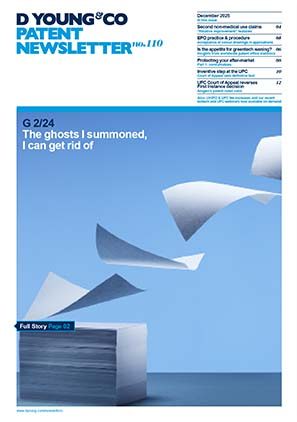Quantum computing: a guide to obtaining patent protection at the EPO
Quantum computing is one of the fastest growing sectors in the patent world, with the rise in international patent filings far out-pacing the average across all technological areas.
This sector presents technical challenges in a range of fields, including engineering, physics, mathematics, and computer science. However, quantum computing also presents some unique challenges when attempting to obtain patent protection for an invention at the European Patent Office (EPO). This article looks at what these challenges are, and how they can be overcome.
The presence of a technical effect
Quantum computing-based inventions can vary dramatically in form. Inventions in this field can include approaches for improving the physical hardware of quantum computers, such as implementations of qubits themselves or interactions which alter the state of a physical qubit. Other examples include particular algorithms to be executed on quantum computers, or programs for classical computers which improve the functioning of quantum computers.
Inventions in each of these example areas are potentially patentable, provided certain requirements are met.
In addition to the standard requirements that the invention should be novel and involve an inventive step over the state of art, the European Patent Convention (EPC) sets out several exclusions to patentability, including: “discoveries, scientific theories and mathematical methods”, and “programs for computers”, among others.
In other words, if the invention falls solely within the above exclusions the invention is not patentable. However, an invention which partly incorporates any of the above exclusions can be patentable provided a technical effect is achieved. At the EPO a general guideline is that the invention should achieve a technical effect outside of the exclusions listed above. However, the difficulty in demonstrating the presence of such a technical effect often depends upon the particular type of invention.
For quantum computing hardware the technical effect is often immediately apparent, for example, longer coherence times or more precise qubit transformations, and these inventions would evidently fall outside the above exclusions. However, this is not the case for quantum computing algorithms or programs for classical computers related to the functioning of the quantum computer. These types of inventions are instead subject to the EPO’s established approach for assessing computer-implemented inventions (CIIs). Under this approach, only those features of the invention which contribute to providing a technical effect can be considered for the purposes of assessing whether an inventive step is achieved.
In these cases, it is important to consider what the ultimate result of the invention is and whether that ultimate result provides a technical effect. For example, if the ultimate result of an algorithm or program is a generally improved quantum computer or an improved technical system controlled by a quantum computer, then a technical effect may be provided. If, however, the ultimate result of the invention is simply a better computer program, such as a specific program that requires less steps to compute, there is no technical effect beyond the computer program exclusion, and patent protection cannot be obtained.
This requirement of the presence of a technical effect is complicated by the fact that much of the research into quantum computing is driven by mathematics, meaning inventions are often based on ideal logical qubits, rather than physical qubits implemented in hardware. While using logical qubits is important for developing these algorithms, in order to obtain patent protection it is important to consider and describe how the invention can be applied to physical qubits, in order to ensure that a technical effect can be achieved by the invention. For example, if an algorithm involves performing a particular transformation on a qubit the application should describe how this same transformation could be applied to a physical qubit, at least in principle. Failure to include such a description might lead to doubts regarding the extent to which a technical effect is achieved, making obtaining patent protection more challenging.
Sufficient disclosure
One of the more unique challenges associated with quantum computing inventions is ensuring the invention meets the EPO’s requirements of sufficient disclosure. The EPO requires that a patent application describes the invention in such a way that allows a person skilled in that field to put the invention into effect. A key point is that this requirement is assessed at the priority date of the patent application. Therefore, if the invention is an algorithm that is to be executed on a quantum computer then that algorithm must be executable on an existing quantum computer at the priority date of the invention.
This can pose potential challenges due to the infancy of current quantum computing technologies. Current quantum computers generally have small numbers of qubits, for example less than 1000 qubits. Consequently, if the quantum computing algorithm requires more qubits than can be implemented in current quantum computers then the algorithm cannot be put into practice at the priority date. As such, the invention is not sufficiently disclosed and patent protection cannot be obtained.
Applicants should therefore be mindful of the current state of the art for quantum computing hardware, and consider how this relates to their invention. Similarly, quantum computing inventions often relate to complex concepts such as quantum entanglement and manipulating the state of qubits. In order to ensure that the invention is described in a manner which allows it to be put into effect, it should be described how these complex operations can be performed on physical qubits. For example, if the invention involves entanglement of two qubits, the application should describe possible ways in which this could be carried out, at least in principle.
Clarity of the application
Quantum computing it not yet a standardised field, meaning that a particular term used in the context of the invention may take a different meaning in a different context. Moreover, while the EPO permits common general knowledge to be used to interpret the application, the infancy of quantum computing means that it is difficult to identify exactly what is included within said common general knowledge. Applicants should wherever possible provide precise definitions of the terms and expressions used in the application.
A further difficulty is that as quantum computing is still an emerging field, lack of expertise might lead to doubts being raised during examination regarding the extent to which the invention can be put into practice, and whether a technical effect is achieved. As a result, the application should include a simple and clear explanation of all aspects of the invention, and describe in simple terms how the technical effect is achieved. In many cases, it may be appropriate to describe the invention at two levels of detail: a high-level, generalised description which allows non-experts to understand the invention; and a detailed description for experts in the field which would allow the invention to be put into practice.
Outlook
It is likely that the requirements for applicants in the field of quantum computing will become less arduous over time. As quantum computing develops as a field, overall understanding will improve, meaning it will become more straightforward to demonstrate that an invention can be put into practice on existing quantum computing hardware, and it will likely become easier to demonstrate the presence of a technical effect. For the time being however, applicants must still consider these challenges when preparing and filing their patent applications.

